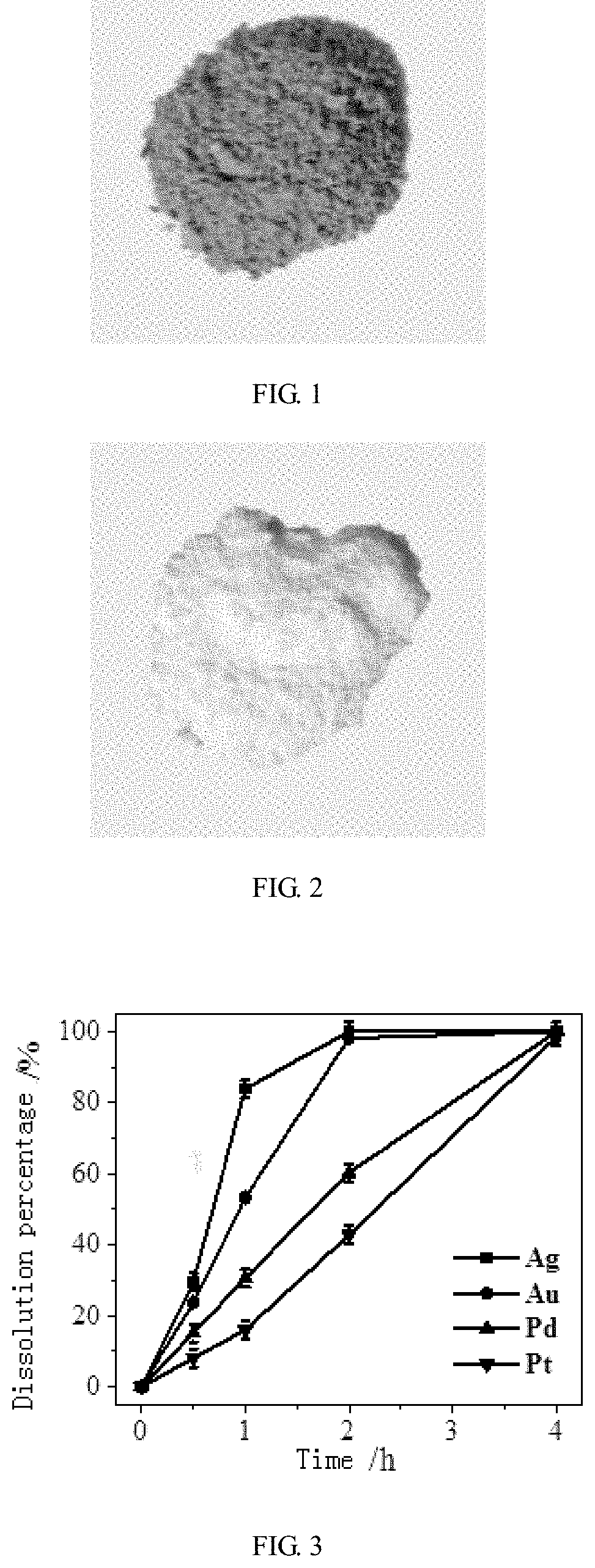Method for dissolving metals by photocatalysis
a technology of photocatalysis and metals, applied in the field of photocatalysis, can solve the problems of 7%-8% of global energy supply, affecting the environment, and the recovery rate of metals remains at a relatively low level, and achieves low toxicity, convenient operation, and low cost
- Summary
- Abstract
- Description
- Claims
- Application Information
AI Technical Summary
Benefits of technology
Problems solved by technology
Method used
Image
Examples
embodiment 1
[0026]500 mg material containing 1% of platinum was dispersed in 50 ml mixed solution of acetonitrile and dichloromethane (50:1). Then, 50 mg mixed-phase titanium dioxide photocatalyst was added. Ultraviolet irradiation proceeded in air for 4 h. The dissolution rate of platinum was 81.6%.
[0027]FIG. 1 and FIG. 2 are sample diagrams before and after the dissolution reaction, respectively. It can be seen that, the sample was gray black before dissolution and was white after the dissolution reaction from FIGS. 1 and 2; and ICP test data in FIG. 3 also apparently show that the ratio of platinum in the liquid increased continuously (a small amount of solution was evaporated to obtain dry solvent, and then water was added in an amount equivalent to that of the solvent to dilute the solvent for testing).
embodiment 2
[0028]500 mg material containing 1% of platinum was dispersed in 100 ml mixed solution of acetonitrile and dichloromethane (50:1). Then, 50 mg mixed-phase titanium dioxide photocatalyst was added. Ultraviolet irradiation proceeded in air for 4 h. The dissolution rate of platinum was 91.4%.
embodiment 3
[0029]500 mg material containing 1% of platinum was dispersed in 200 ml mixed solution of acetonitrile and dichloromethane (50:1). Then, 50 mg mixed-phase titanium dioxide photocatalyst was added. Ultraviolet irradiation proceeded in air for 4 h. The dissolution rate of platinum was 100%.
PUM
| Property | Measurement | Unit |
|---|---|---|
| light wavelength | aaaaa | aaaaa |
| semiconductor | aaaaa | aaaaa |
| mass ratio | aaaaa | aaaaa |
Abstract
Description
Claims
Application Information
 Login to View More
Login to View More - R&D
- Intellectual Property
- Life Sciences
- Materials
- Tech Scout
- Unparalleled Data Quality
- Higher Quality Content
- 60% Fewer Hallucinations
Browse by: Latest US Patents, China's latest patents, Technical Efficacy Thesaurus, Application Domain, Technology Topic, Popular Technical Reports.
© 2025 PatSnap. All rights reserved.Legal|Privacy policy|Modern Slavery Act Transparency Statement|Sitemap|About US| Contact US: help@patsnap.com

